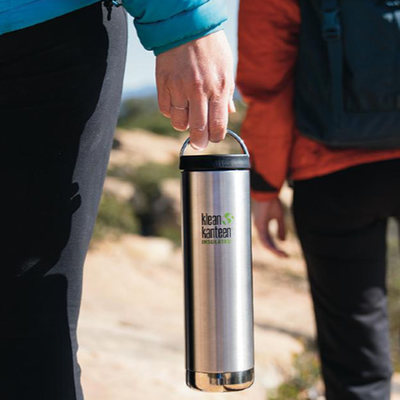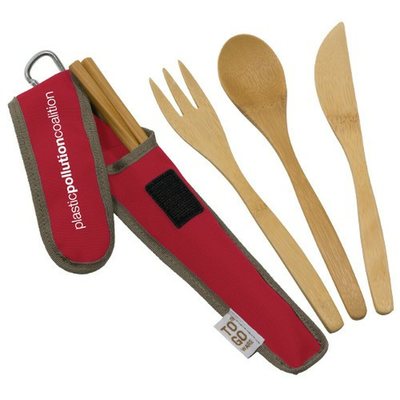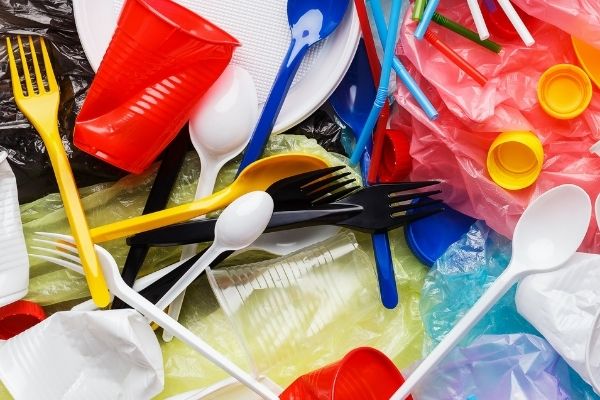We are so used to our convenient lifestyles that we don’t often take cognizance of our actions. In many ways, single-use plastics are the enablers of this modern, convenience-driven lifestyle. Allowing us to prepare less, think less, and be less conscious. So what are single-use plastics, and what part do they play in our lives?
A fork with our takeaway noodles, a coffee cup lid so our coffee doesn’t spill, a stirrer to stir our sugar into our tea, a plastic packet to carry our groceries or a paper takeaway box.
Currently, about 300 million tons of plastic are produced every year. That plastic is used in many single-use plastic items that everyday people use.
- Americans consume 70 million water bottles a day
- 2.5 billion coffee cups are used and thrown away each year in the UK
- The world uses 5 trillion plastic bags… per year! That’s 160,000 a second!
- Australians use more than 7 million plastic utensils a day.
- Americans use more than 500 million straws every day.
- 1.8 billion cotton buds every year in the UK
“It’s just one”, said 7.6 billion people.
Below we explain what these single-use plastics are and what’s so bad about them. Plus, we will show you ways you can reduce your usage and make a difference.
What are single-use plastics?
Single-use plastics are made from plastics and are meant to be used only once and then thrown away. They include disposable items like plastic cutlery, plastic straws, water bottles, and most food packaging.
Single-use plastics are mostly, if not always, used in the food, medical, and personal care industries. Many items are labeled single-use but can be used multiple times.
Whether something is single-use usually depends on the occasion. If you are on the go, the item has a higher chance of being used only once and then discarded than when you are at home.
What are common examples of single-use plastics?
Examples of single-use items that need to be thrown away after one use:
- Party balloons
- Earbuds
- Coffee cups and lids
- Styrofoam/polystyrene containers
- Paper plates
- Cigarettes
- Tissues, paper towel
- Medical or cleaning gloves
- Most packaging from food and other goods

Examples of single-use items that can technically be used again if they are washed:
- PET plastic bottles
- Plastic straws
- Drink stirrer
- Plastic cutlery
- Plastic cups
- Plastic plates
*The above is not an exhaustive list
What is so bad about single-use plastics?
Single-use plastics are made primarily from fossil fuels. It takes a great deal of effort and energy to extract these materials from the earth, process them, and manufacture them into packaging and other single-use items.
All this effort and then they just get thrown away!
There are many reasons why single-use plastics are bad, and we should avoid them, including:
- Most single-use plastic items are not designed to be recycled.
- Many single-use plastics don’t have a polymer identification code. This means that if the item gets to a recycling plant, there is no way to identify the plastic type. That’s why many of these items aren’t accepted in your curbside recycling. If an incompatible plastic gets into a particular recycling machine, it can clog it up.
- Many single-use items are made from multi-layer materials. In most cases, this makes it extremely difficult to recycle as there isn’t equipment available to separate the materials.
- If single-use plastics are left in the environment, they won’t break down, but they will break up. Over time, heat and light from the sun will break down the plastic into tiny pieces called microplastics.
- Many single-use plastics are lightweight:
- The wind is likely to blow these items into rivers and oceans.
- In informal economies, waste-pickers/collectors collect recyclable materials and take them to buy-back centers to get money. They are unlikely to collect single-use items as they don’t weigh a lot, and therefore they won’t get a lot of money back for them.
- Toxic chemicals used to make these plastics can end up leaching into the environment or tissues of animals when they break down.

It’s important to acknowledge that some single-use plastic items play an important role and are not just for convenience. Plastic is a versatile material and sometimes has a valuable role to play in society.
Some single-use items can be important in certain circumstances, for example, straws for people with disabilities or single-use personal protective equipment like surgical gloves or masks.
Should we ban single-use plastics?
When thinking about this question, it is important to think about the true impacts. What do we mean? Let’s take the example of a plastic bag.
Many countries have been implementing plastic bag bans over the last five years. This is great; however, when looking at the alternatives like paper bags or cotton bags, we must consider whether they have a greater negative environmental impact.
For example, a study showed that paper bags could require 400% more energy to produce. In addition, paper requires the harvesting of trees and toxic chemicals in the production process.
When it comes to cotton bags, studies completed in Denmark and the UK (amongst others) found that they have the worst environmental impacts of all bags. This is even when considering that they can be reused many more times than plastic or paper.
So we need to make sure that if we implement bans, that “careless” swops don’t happen, which could have unintended consequences.
The idea of bans is controversial, however, they do prevent millions of items from being produced and entering into waste streams and the environment.
Banning single-use plastics reduces pollution, waste in the environment, waste in landfills, and micro-plastics which often end up in wildlife. Banning this plastic also decreases the demand for the natural resources required to make them. This puts less pressure on our precious earth.
The bottom line is that bans need to be thoroughly informed and monitored. This helps ensure what we are switching to will not have unintended consequences that are worse than what we are banning.
Many Countries Have Already Banned Single-use Plastics
According to the World Economic Forum, many countries and cities have succeeded in decreasing or banning single-use plastics. Last year, 170 nations pledged to “significantly reduce” the use of plastic by 2030. However, many have already started by proposing or imposing rules on certain single-use plastics.
Here are some great examples:
- Kenya – banned single-use plastic bags in 2017. The country has forbidden visitors from taking single-use plastics, e.g., water bottles and disposable plates, into national parks, forests, beaches, and conservation areas. You can read about more plastic bans here.
- Zimbabwe – introduced a ban on polystyrene food containers in 2017, with fines of between $30 to $5,000.
- United Kingdom – introduced a tax on plastic bags in 2015 and banned the sale of products containing microbeads, e.g., shower gels and face scrubs, in 2018. A ban was recently enforced on plastic straws, stirrers, and cotton buds.
- United States – California, Connecticut, Delaware, Hawaii, Maine, New York, Oregon, and Vermont have banned single-use plastic bags, though there is no federal ban.
- The European Union – plans to ban single-use plastic items such as straws, forks, knives, and cotton buds by 2021.
- China – has banned single-use plastic straws and shopping bags in major cities.
What Can You Do To Help?
Be a conscious consumer
Be curious about your world. Stop and think about what you are doing. Ask yourself questions like “how long am I going to use this item for vs. how long will it stay in landfill or the environment?” or “do I really need this item?”.
Learn more in What Does it Mean to be a Conscious Consumer?
Keep in mind that some items are single-use for a good reason. Consider the purpose of the item. Such items might be medical equipment designed to be single-use for safety reasons.
Offer your support
Support government bills or initiatives to limit single-use plastics.
Speak up against companies that are using single-use plastics. Don’t be afraid to ask a company to make the switch and stop using single-use plastics. But be polite and remember most businesses are just trying to make ends meet. Maybe they have never considered the impacts of the single-use items and will appreciate your suggestions.
Recycle What You Can
Many countries are introducing soft plastic recycling where plastic bags and other soft plastic packaging can be recycled. You can learn more in our article Recycling plastic bags and soft plastics.
Be sure to dispose of your hard plastics correctly too. Check with your local authority or read more in our articles:
- How to Recycle: Recycling Symbols and Meanings
- How to make sense of plastic by numbers
- How to recycle: The Quick Reference Guide for Curbside Recycling.
Bring your own
Carry your own takeaway containers, reusable coffee cup, and cutlery set everywhere you go so you never get caught out. It’s also a good idea to keep a set in your car or at work.
If you have no choice and need to use a single-use item, keep it and reuse it, e.g., cutlery or chopsticks.


As for reusable shopping bags, there are plenty of bags available made from recycled or upcycled fabrics. These are our recommended options as they use materials already in circulation.
Making these changes can be difficult and takes practice. It can feel inconvenient at first, but the more often you make these small changes, the easier they will become.
Sources
- The World Counts
- House of Commons Environmental Audit Committee, 2017, Disposable Packaging: Coffee Cups
- Plastic Free Beaches
- Container Recycling Institute, Plastic water bottles should no longer be a wasted resource.
- ‘Six to solve’: How Australia could halve the amount of plastic waste leaked into the environment














